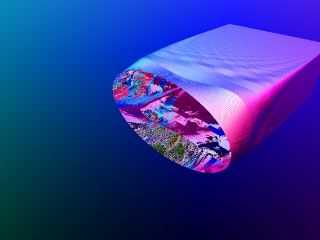 |
 |
|
 |
|
 |
|  |
|  |
|
 |
|
 |
|  |
|  |
|
 |
I took the Fourier transform of motion at constant speed around a
rectangle. The ellipse at the foreground end of this tube is the first
nonzero component of the resulting series; it is quickly squared off as
higher-frequency components are added (180 in all).
(It's a mesh with 360*180 vertices.)
On the way to this image, I learned a better understanding of Fourier
series!
--
Anton Sherwood
Post a reply to this message
Attachments:
Download 'squaround.jpg' (10 KB)
Preview of image 'squaround.jpg'

|
 |
|  |
|  |
|
 |
|
 |
|  |
|  |
|
 |
I assume that as we look towards the back of the object, we see the places
where more terms have been added. So, as you added term after term, how did
you calculate the value "inbetween" the terms? linear interpolation?
Is this a parametric object or a mesh?
- Slime
[ http://www.slimeland.com/ ]
[ http://www.slimeland.com/images/ ]
"Anton Sherwood" <bro### [at] pobox com> wrote in message
news:3BD286CA.439974CD@pobox.com...
> I took the Fourier transform of motion at constant speed around a
> rectangle. The ellipse at the foreground end of this tube is the first
> nonzero component of the resulting series; it is quickly squared off as
> higher-frequency components are added (180 in all).
>
> (It's a mesh with 360*180 vertices.)
>
> On the way to this image, I learned a better understanding of Fourier
> series!
>
> --
> Anton Sherwood
----------------------------------------------------------------------------
---- com> wrote in message
news:3BD286CA.439974CD@pobox.com...
> I took the Fourier transform of motion at constant speed around a
> rectangle. The ellipse at the foreground end of this tube is the first
> nonzero component of the resulting series; it is quickly squared off as
> higher-frequency components are added (180 in all).
>
> (It's a mesh with 360*180 vertices.)
>
> On the way to this image, I learned a better understanding of Fourier
> series!
>
> --
> Anton Sherwood
----------------------------------------------------------------------------
----
Post a reply to this message
|
 |
|  |
|  |
|
 |
|
 |
|  |
|  |
|
 |
When I showed this image to my dad, he saw it as something flat, and
took the colors within the ellipse to be the important part -- and was
baffled that I said it had something to do with Fourier series!
As usual, I used a shiny texture and a multicolored sky. Rays within
the tube bounce around and emerge at `random' angles, whence the chaos.
Slime wrote:
> I assume that as we look towards the back of the object, we see the
> places where more terms have been added. So, as you added term after
> term, how did you calculate the value "inbetween" the terms? linear
> interpolation?
Yes. See the creases at the first few terms?
> Is this a parametric object or a mesh?
>
> "Anton Sherwood" <bro### [at] pobox com> wrote
> > (It's a mesh with 360*180 vertices.)
--
Anton Sherwood com> wrote
> > (It's a mesh with 360*180 vertices.)
--
Anton Sherwood
Post a reply to this message
|
 |
|  |
|  |
|
 |
|
 |
|  |
|  |
|
 |
Coooool.
- Slime
[ http://www.slimeland.com/ ]
[ http://www.slimeland.com/images/ ]
"Anton Sherwood" <bro### [at] pobox com> wrote in message
news:3BD65E8F.7A93C356@pobox.com...
> When I showed this image to my dad, he saw it as something flat, and
> took the colors within the ellipse to be the important part -- and was
> baffled that I said it had something to do with Fourier series!
>
> As usual, I used a shiny texture and a multicolored sky. Rays within
> the tube bounce around and emerge at `random' angles, whence the chaos.
>
>
> Slime wrote:
> > I assume that as we look towards the back of the object, we see the
> > places where more terms have been added. So, as you added term after
> > term, how did you calculate the value "inbetween" the terms? linear
> > interpolation?
>
> Yes. See the creases at the first few terms?
>
>
> > Is this a parametric object or a mesh?
> >
> > "Anton Sherwood" <bro### [at] pobox com> wrote in message
news:3BD65E8F.7A93C356@pobox.com...
> When I showed this image to my dad, he saw it as something flat, and
> took the colors within the ellipse to be the important part -- and was
> baffled that I said it had something to do with Fourier series!
>
> As usual, I used a shiny texture and a multicolored sky. Rays within
> the tube bounce around and emerge at `random' angles, whence the chaos.
>
>
> Slime wrote:
> > I assume that as we look towards the back of the object, we see the
> > places where more terms have been added. So, as you added term after
> > term, how did you calculate the value "inbetween" the terms? linear
> > interpolation?
>
> Yes. See the creases at the first few terms?
>
>
> > Is this a parametric object or a mesh?
> >
> > "Anton Sherwood" <bro### [at] pobox com> wrote
> > > (It's a mesh with 360*180 vertices.)
>
>
> --
> Anton Sherwood com> wrote
> > > (It's a mesh with 360*180 vertices.)
>
>
> --
> Anton Sherwood
Post a reply to this message
|
 |
|  |
|  |
|
 |
|
 |
|  |




![]()